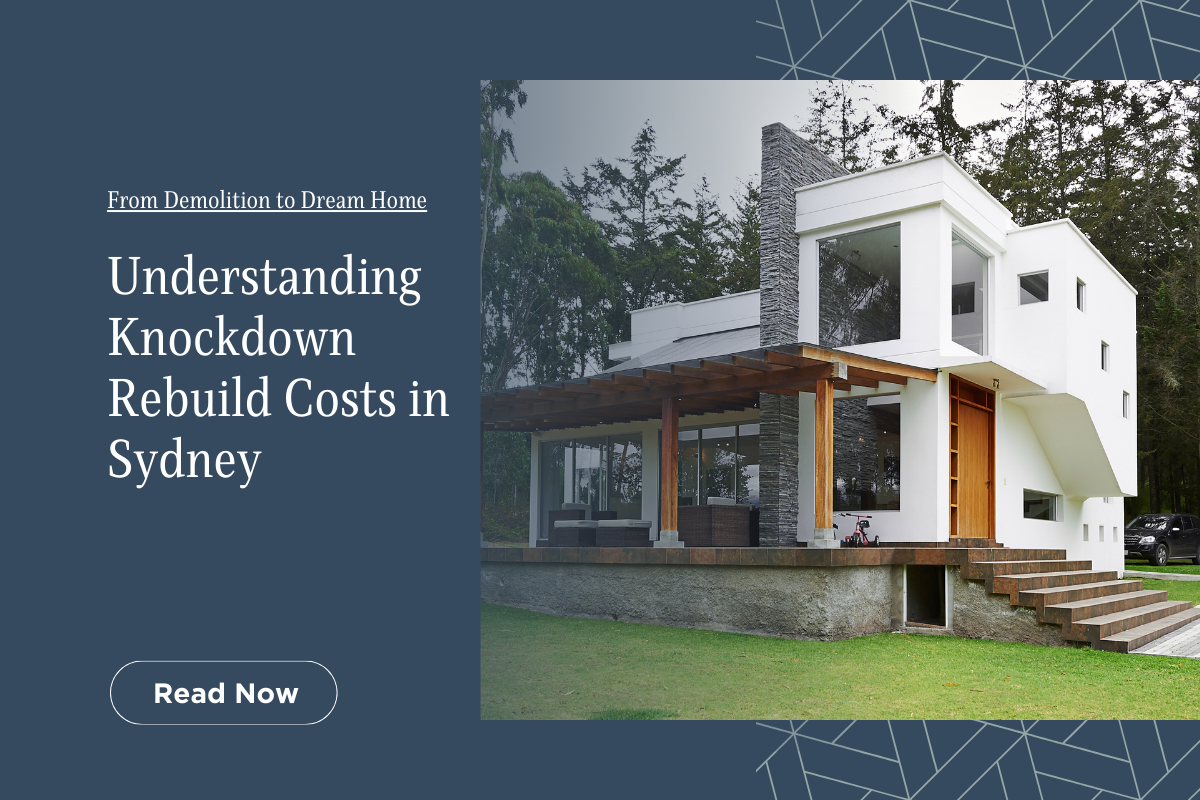If your current home no longer meets your needs or aligns with your vision, a knockdown and rebuild might be the solution you’ve been seeking. By demolishing your existing property and rebuilding a brand-new home tailored to your preferences, you can transform your living situation into an oasis that truly reflects your lifestyle and aspirations. However, before embarking on this exciting journey, it’s crucial to understand the costs involved to ensure a smooth and well-planned process.
In this comprehensive guide, we’ll delve into the details of knockdown rebuild costs in Sydney, providing you with the knowledge and insights necessary to make informed decisions and prepare for the financial commitment ahead.
Understanding the Process: From Demolition to Reconstruction
A knockdown rebuild project involves several stages, each with its own associated costs. Let’s break it down:
1.Demolition: The first step is to demolish your existing home, which includes the cost of obtaining necessary permits, hiring a demolition contractor, and safely removing all structures on the property.
2.Site Preparation: Once the demolition is complete, the site must be prepared for new construction. This may involve clearing the land, levelling the ground, and addressing any potential environmental or zoning issues.
3.Design and Planning: Engaging an architect or designer is crucial to bringing your dream home vision to life. Their expertise will help you navigate the complexities of designing a functional and aesthetically pleasing home while adhering to local building codes and regulations.
4.Construction: The heart of the knockdown rebuild project lies in the construction phase, which includes costs for materials, labour, permits, and various trades such as plumbing, electrical, and HVAC systems.
5.Landscaping and Finishing Touches: Once the main construction is complete, you’ll need to allocate funds for landscaping, driveway installation, fencing, and any additional finishes or customisations to truly make your new home your own.
Knockdown Rebuild Costs: Breaking Down the Numbers
Now that you understand the overall process, let’s dive into the specific knockdown rebuild costs you can expect in Sydney. These costs can vary significantly based on factors such as the size of your property, the complexity of the design, the quality of materials chosen, and the suburb.
1.Demolition Costs: Demolishing an existing home typically ranges from $15,000 to $30,000 or more, depending on the size and complexity of the structure.
2.Site Preparation Costs: Clearing the land, addressing environmental concerns, and levelling the ground can cost anywhere from $5,000 to $20,000 or more, depending on the condition of the site.
3.Design and Planning Costs: Engaging an architect or designer can cost between $10,000 and $50,000 or more, depending on the complexity of the project and the level of customisation required.
4.Construction Costs: The bulk of your knockdown rebuild costs will be allocated to the construction phase, which can range from $300,000 to over $1 million or more, depending on the size of the home, the quality of materials used, and the level of finishes and customisations desired.
5.Landscaping and Finishing Touches: Allocate approximately $20,000 to $100,000 or more for landscaping, driveways, fencing, and any additional finishes or customisations.
It’s important to note that these cost estimates are rough approximations, and your actual costs may vary significantly depending on your specific project requirements and suburb.
Factors Influencing Knockdown Rebuild Costs
While the cost ranges provided above can serve as a general guide, several factors can significantly impact the overall knockdown rebuild costs. Understanding these factors will help you plan and budget more accurately:
1.Location: The location of your property plays a crucial role in determining costs. Areas with higher land values, stricter building regulations, or limited access may result in higher costs for materials, labour, and permits.
2.Property Size: The larger the property and the desired home size, the higher the costs will be for demolition, construction materials, labour, and landscaping.
3.Design Complexity: Intricate designs, custom features, and unique architectural elements can significantly increase the overall costs due to the complexity of execution and the specialised materials and labour required.
4.Material Choices: The quality and type of materials you select for your new home, such as luxury finishes, high-end appliances, and premium construction materials, will directly impact the overall costs.
5.Labour Costs: The cost of skilled labour, including contractors, tradespeople, and construction workers, can vary greatly depending on the demand and availability in your specific area of Sydney.
6.Permits and Regulations: Navigating local building codes, zoning laws, and obtaining necessary permits can add additional costs to your project.
7.Site Conditions: Factors such as sloping terrain, soil conditions, or the presence of underground utilities or structures can increase site preparation and construction costs.
8.Project Timeline: Longer construction timelines can result in additional costs due to factors such as extended labour, equipment rentals, and potential material price fluctuations.
By carefully considering these factors and working closely with professionals, you can develop a more accurate estimate of the costs for your project.
Budgeting and Planning for a Successful Knockdown Rebuild
Proper planning and budgeting can help ensure a smooth and stress-free experience. Here are some tips to help you navigate the financial aspects of your project:
1.Set a Realistic Budget: Determine your overall budget by considering your financial resources, desired home specifications, and estimated costs based on the factors mentioned above.
2.Create a Contingency Fund: Unexpected costs are common in construction projects, so it’s crucial to allocate a contingency fund, typically 10-20% of your overall budget, to cover any unforeseen expenses.
3.Explore Financing Options: If your savings are insufficient, explore financing options such as construction loans, home equity loans, or personal loans to cover the costs of your knockdown rebuild project.
4.Prioritise and Compromise: If your desired features exceed your budget, prioritise your must-haves and be willing to compromise on less crucial elements to keep costs in check.
5.Seek Professional Guidance: Work closely with experienced professionals, including architects, builders, and project managers, who can provide accurate cost estimates and guide you through the entire process.
6.Consider Resale Value: While creating your dream home is the primary goal, keep in mind the potential resale value of your new property, as this can influence the return on your investment.
Conclusion
Embarking on a knockdown rebuild project is an exciting endeavour, offering the opportunity to create a home that truly reflects your lifestyle. However, understanding the associated costs is crucial for a smooth and successful journey from demolition to your dream home. Remember, the key is to work closely with experienced professionals, set realistic expectations, and prioritise your must-haves while remaining open to compromises when necessary.
If you’re still unsure about the costs or the process, consider reaching out to our expert team at Tailored Homes, a trusted name in the Sydney construction industry. Our expertise and experience in knockdown rebuild projects can provide valuable insights and guidance, ensuring that your dream home becomes a reality within your desired budget.
Embrace the excitement of creating your perfect living space. With meticulous planning and a solid understanding of the knockdown rebuild costs, you can embark on this transformative journey with confidence and peace of mind.

 No variations
No variations Workmanship warranty
Workmanship warranty 5 Star Google Ratings
5 Star Google Ratings Experienced civil engineers
Experienced civil engineers

